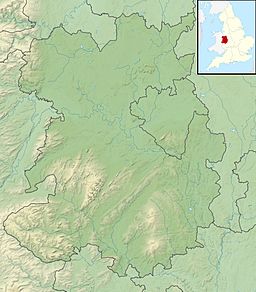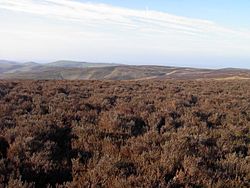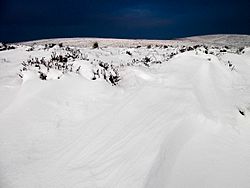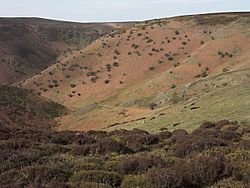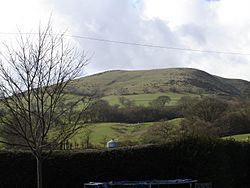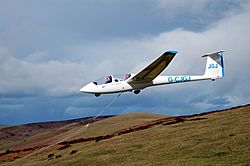Long Mynd facts for kids
Quick facts for kids Long Mynd |
|
|---|---|
| Welsh: Mynydd Hir | |
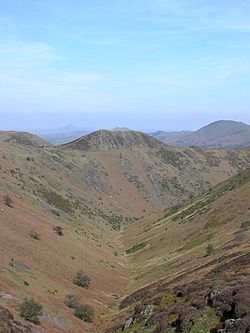
View down Townbrook Valley toward Burway Hill
|
|
| Highest point | |
| Peak | Pole Bank |
| Elevation | 516 m (1,693 ft) |
| Dimensions | |
| Length | 11.26 km (7.00 mi) N-S |
| Width | 4.8 km (3.0 mi) E-W |
| Area | 54 km2 (21 sq mi) |
| Geography | |
| Country | England |
| Range coordinates | 52°32′51.90″N 2°50′20.02″W / 52.5477500°N 2.8388944°W |
| Biome | Heathland Moorland |
| Geology | |
| Formed by | Glaciation |
| Age of rock | Quaternary |
| Type of rock | Sandstone |
The Long Mynd is a heath and moorland plateau that forms part of the Shropshire Hills in Shropshire, England. The high ground, which is designated as an Area of Outstanding Natural Beauty, lies between the Stiperstones range to the west and the Stretton Hills and Wenlock Edge to the east. Much of it is owned and managed by the National Trust.
The Long Mynd is approximately 7 miles (11 km) long by 3 miles (5 km) wide, and is broadly characterised by steep valleys on its eastern flanks, and a long slope to the western side rising in a steep escarpment. In its vicinity are the principal settlements of Church Stretton, Little Stretton and All Stretton, Pulverbatch, Smethcott, Woolstaston, Asterton, Myndtown, Wentnor and Ratlinghope.
The highest point on the Long Mynd is Pole Bank (1,693 ft, 516 m); this and the adjacent hill of Caer Caradoc (1,506 ft, 459 m) are classed as Marilyns.
Contents
Etymology
The name Long Mynd means "Long Mountain", the second element being Brittonic in origin. In modern Welsh it is named Mynydd Hir which has the same meaning.
Geology
The geology dates back to the Precambrian, and during at least part of that long period the feature would have been around 60° south of the equator, the same as the current latitude of the Falkland Islands. Shropshire would have been at the very edge of a large continent near the sea, which was being buckled by tectonic activity, causing volcanoes to form. The area had broad rivers; evidence of mudflats has been found. The rivers would have flowed out to sea, creating large estuaries; over time, the mudflats would have built up, and volcanic eruptions deposited ash in layers between the sand and mud. The primary rock of the Long Mynd is sandstone, usually coloured purple or grey. The volcanoes created the nearby Stretton Hills and the Wrekin, and eruptions would have been frequent. There are layers in the rocks of the Long Mynd that were previously described as raindrop marks. Unpublished research, including electron micrographs, by the now deceased Professor Martin Brasier, showed that these are actually ichnofossils created by an unknown Ediacaran biota. Field observations of the stratigraphy present, and its laminar nature, leave no doubt that they are in a marine environment; the absence of infilled or mineralised syncresis (shrinkage cracks) adds to this. Examples of these fossilised marks can be viewed today in the National Trust Tearoom Exhibition, in Carding Mill Valley. The layers of rock built up over the millennia to create an approximately 23,000 ft (7,000 m) thick layer composed of sand, mud, silt and very occasional thin ash bands. The stratigraphy, mineral compositions and surrounding volcanology suggests an infilling island arc basin.
Towards the end of the Precambrian period, the volcanoes ceased their eruptions, and the rivers had dried up. Instead the forces that created the volcanoes caused the new rocks to lift and fold, creating mountains and valleys in the area. Much of the rock was melted during this period, underneath the Earth's crust, causing the mountains to continually change towards the latter part of the Precambrian. The Church Stretton Fault zone probably formed during this period. It is still active today. The hill Caer Caradoc adjacent to the Long Mynd and from the same time is volcanic in origin, and is thought to be a remnant of the great mountain chain.
During the Cambrian, Shropshire was flooded by the sea, after the Global Ice Age ended 545 million years ago. Thick layers of beach pebbles and white sand were built up against the sea cliffs that were once molten lava. During this time, the shallow sea played host to the huge explosion of new life which occurred during the Cambrian. Shropshire has some of the most historically important evidence in the explosion of life and this is referred to in the naming and dividing of the Cambrian period. Trilobites that are found in the county are internationally important for deciding how the Cambrian is divided into smaller segments of time.
The Ordovician had Shropshire back to volcanic activity, and saw the county temporarily split in two, along the Pontesford – Linley fault line. Everything west of this line was ocean, while the east was dry land. The Iapetus Ocean was closing, bringing the two halves of Britain towards each other, and volcanic eruptions created the Cumbrian Mountains and Snowdonia. Shropshire also saw volcanic activity. To the west of the Pontesford – Linley fault, volcanic rocks have been found. The other side of the fault line was quieter. The land was slowly eroded, and the sea gradually flooded it, so that only the tops of hills could be seen, such as the ancient Caer Caradoc. Towards the end of the Ordovician, the sea levels dropped, due to another ice age. An interesting observation of this erosion can be found in the stratigraphy as a sea stump (an eroded sea stack).
The Silurian period, around 439 million years ago, has been well preserved nearby, in Wenlock Edge. During this time, Shropshire would have been flooded again by shallow sea. Wenlock Edge would have formed during this time, and the fossils of ancient corals and shellfish can be found all along the edge, preserved in limestone. Towards the end of the Silurian the Iapetus Ocean would have fully closed, and England and Scotland were joined. The closing of this ocean was important to geology in Great Britain. It caused most of our hills and mountains to align along the fault, northeast to the southwest.
During the Devonian, the newly formed Scottish mountains had rivers flowing all over the land. Shropshire was no exception; these new rivers caused thick deposits in the area. Most of the rocks from this era are red sandstones, with iron in the rock. The area was known as the Old Red Sandstone Continent. These river sediments have traces of fossilised fish. Shropshire would have remained above water until the end of the Devonian, when the seas rose once again.
The Carboniferous was a time of great change for the area. Shropshire would have been near the equator, and the Old Red Sandstone continent had been eroded away; in the early part of the era, the county was under a shallow sea. However, tectonic activity pushed Britain out of the sea. South of Shropshire this effect was felt greatly, though Shropshire was relatively quiet. Mountains to the north were being worn down by rivers, creating enormous deltas that were colonised by plant life. A tropical forest took hold all over Shropshire, with ancient tree ferns and horsetails. Shropshire eventually crossed the equator during this era, and became a part of Pangaea during the Permian; the area would have been very similar to the Sahara Desert, and would have been in the vicinity, around 20° to 30° north of the equator.
The Triassic, Jurassic, Cretaceous and Tertiary were very quiet in Shropshire, and very little evidence can be found from these periods. The last Ice Age during the Quaternary has its effect on all of Shropshire, shaping the landscape as we see it today. The Long Mynd would have been under a thick ice sheet, several hundred metres thick. As the ice melted, it carved out the valleys and hills of the Long Mynd massif we see today. The small rivers, streams and brooks still very slowly carve out the valleys.
Today the steep and narrow valleys are covered in a thin layer of acidic soil, able to support only strong grasses, rushes and heathers. Beneath the soil the evidence of the ancient and chequered past can be seen, and the rocky outcrops and scree slopes are excellent places to view the different layers of ancient rock.
From 2006, University of Cambridge scientists monitored seismic activity in the Long Mynd. The broadband seismometer was connected to the internet, and real-time traces viewable online.
History
Bronze Age
The Bronze Age period is by far the most recorded period of time on the Long Mynd. There are dozens of tumuli on the moorland. Some are small, the remains of chamber tombs for example. Others are quite large, the sites on the Long Mynd, from the Bronze Age, include dykes and barrows.
Barristers Plain Cross-Ridge Dyke runs southwest to northeast, almost in a straight line for 170 m (560 ft). It runs across the narrowest area of a ridge between Grindle Hill and Round Hill. The remains of the dyke is now covered in heather, and is approximately 5.5 m (18 ft) wide, and is 0.5 m (1 ft 8 in) high. On its western side it is fronted by a 3 m (10 ft) wide ditch. At both ends of the Cross Ridge Dyke, it fades into the steep hillside. A gap in the dyke, 60 m (200 ft) from the south-east end, is thought to make room for a trackway along the ridge. Its purpose was to cut off Grindle Hill from the main plateau, and to create a barrier for access from the west.
Devil's Mouth Cross-Ridge Dyke lies between Cardingmill Valley and Townbrook Valley. The dyke is 140 m (460 ft) long, but is cut though by the Burway road and a small car park, 35 m (110 ft) of the dyke is now missing. Both ends of the dyke end on steep slopes! It was built with stone and earth, and is 6 m (20 ft) wide, and 1.5 m (5 ft) high, with shallow ditches either side. It is roughly 1,500 years old. It was probably built to control the access along the ancient east to west route, which still crosses the Long Mynd today by means of a modern road.
High Park Cross-Ridge Dyke, another dyke on the Long Mynd. At 380 m (1,250 ft) it is the longest on the Long Mynd. It is approximately 6 m (20 ft) wide, but in areas survives only as a crop mark. The highest point of the dyke, on the west side of the bank, stands at 1.2 m (4 ft) high, and reaches its widest point at 8 m (26 ft). A trackway, like that found on Barristers Plain Cross-Ridge Dyke, cuts through the dyke.
Of the Long Mynd Barrows, over twenty scatter the plateau. The best examples are in the northern area of the Long Mynd. Robin Hood's Butts barrow, near Duckley Nap, are two well known barrows, and the largest on the Long Mynd, being approximately 36 m (118 ft) in diameter and 4 m (13 ft) high.
The Shooting Box Barrow is named after a grouse-shooting hut that stood on the site until it was removed in 1992. It is the only known example of a disc barrow in Shropshire. 21 m (69 ft) in diameter and 2.3 m (8 ft) high, it is in the centre of a flat circular enclosure 54 m (177 ft) in diameter, the edge of which is defined by a 5 m (16 ft) wide bank, which has been partially destroyed by a modern path. It had been dated to c. 1950–1700 BC.
The Port Way is an ancient trackway, which runs the length of the Long Mynd massif, and is the largest historical feature on the Long Mynd, at just over 5 miles (8 km) long. It is still walked today, and is part of the Shropshire Way, and a road that goes to the Gliding Club. A common misconception is that it goes over Pole Bank, but instead it bypasses the hill, following its contours.
Iron Age
Very little Iron Age human activity has been recorded on the Long Mynd. However, this later period has a specific ancient site.
Bodbury Ring Hill Fort, a hill fort above Cardingmill Valley, and sits on the top of Bodbury Hill at 380 m (1,250 ft). This feature dates from the Iron Age, c. 500 BC, and is therefore much later than other ancient sites on the Long Mynd. Another hill fort nearby sits on the summit of Caer Caradoc. Bodbury Ring is now looked after by the National Trust.
18th century
During the 18th century, Church Stretton began to grow in the wide valley between the Long Mynd and Caer Caradoc, as a market town, and later a spa. Historically the town was known for its textiles, specifically in Cardingmill Valley. Carding Mill was built in the 18th century, and named after a stage in making cloth, the three stages being carding, spinning and weaving. Carding would have been done by children, and involved using a hand-card that removed and untangled short fibres from the mass of raw material. The cards were wooden blocks with handles and covered in metal spikes, which were angled, (to make it easier to untangle) and set in leather. When untangled, the material would be spun, and then weaved into the final product. The mill is still in the valley today, but has been converted into luxury apartments. The Long Mynd Hotel in Church Stretton was built in 1900, originally as the Hydro, at a time when the town was popular as a spa.
20th century
A large area of the Long Mynd (almost all its upland area) was bought by the National Trust in 1965, and was designated an AONB as part of the Shropshire Hills in 1958.
Highest points
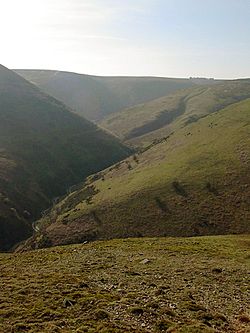
The Long Mynd comprises many hills and moors. From the summit of nearly every hill, there are extensive views of the surrounding area and surrounding counties. North, one can see as far as Cheshire; west commands views over the Stiperstones, and the Welsh Cambrian Mountains in Powys, notably the Cambrian and Berwyn Mountains, and as far as Snowdonia on clear days. The views east are obscured by other areas of the Shropshire Hills, Caer Caradoc, the Wrekin and the Clee Hills. From some locations there are views of the West Midlands. Views south show the Clun Forest, and towards the Craven Arms and Ludlow. The highest points on the Long Mynd are as follows in order of highest to lowest, with comparisons of other nearby hills and the level of Church Stretton in bold.
- Brown Clee Hill 546 m (1,791 ft)
- Stiperstones 536 m (1,759 ft)
- Pole Bank 516 m (1,693 ft)
- Long Synalds 490 m (1,608 ft)
- Wild Moor 487 m (1,598 ft)
- Calf Ridge 468 m (1,535 ft)
- Haddon Hill 467 m (1,532 ft)
- Yearlet 465 m (1,526 ft)
- Round Hill 463 m (1,519 ft)
- Caer Caradoc 459 m (1,506 ft)
- Grindle 459 m (1,506 ft)
- Knolls 456 m (1,496 ft)
- Minton Hill 453 m (1,486 ft)
- Cow Ridge 450 m (1,476 ft)
- Packetstone Hill 437 m (1,434 ft)
- Nills 427 m (1,401 ft)
- Ashlet 415 m (1,362 ft)
- Black Knoll 415 m (1,362 ft)
- Callow 411 m (1,348 ft)
- The Wrekin 407 m (1,335 ft)
- Burway Hill 391 m (1,283 ft)
- Churchmoor Hill 394 m (1,293 ft)
- Bodbury Hill 388 m (1,273 ft)
- Priors Holt Hill 383 m (1,257 ft)
- Adstone Hill 369 m (1,211 ft)
- Shooters Knoll 365 m (1,198 ft)
- Stanyeld 334 m (1,096 ft)
- Novers Hill 305 m (1,001 ft)
- Castle Hill 218 m (715 ft)
- Church Stretton 192 m (630 ft)
Valleys, hollows and batches
Long Mynd comprises a multitude of valleys and the highest concentration lies along the eastern edge, near Church Stretton. Topographically many of the larger valleys lie adjacent to each other and are aligned northwest to southeast. The main valleys include:
- Ashes Hollow
- Barristers Batch
- Bilbatch
- Broadhill Dale
- Burnells Brook
- Callow Hollow
- Carding Mill Valley
- Catbatch Brook
- Cwmdale
- Devils Mouth Hollow
- Gogbatch
- Grindle Hollow
- Hawkham Hollow
- Hens Batch
- High Park Hollow
- Jonathon’s Hollow
- Light Spout Hollow
- Long Batch
- Minton Batch
- Motts Road
- Mount Gutter
- New Pool Hollow
- Nut Batch
- Pike Hollow
- Rams Batch
- Sleekstone Bank Hollow
- Stanbatch
- Stony Batch
- Townsbrook Valley
- Woolers Batch
- Yewtree Batch
Tourism and recreation
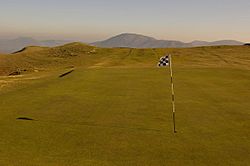
Long Mynd is part of the Shropshire Hills designated Area of Outstanding Natural Beauty (AONB) and is a popular tourist destination, particularly due to the many footpaths, varied terrain and impressive scenery and views. Two major footpaths are the Shropshire Way and the Jack Mytton Way. The Long Mynd's open spaces make it a popular place for horse riding and mountain biking on the bridleways.
Cardingmill Valley is the busiest location as it is home to the National Trust's centre for the area.
The windward slopes to the west are popular with glider, hang-glider and paraglider pilots.
In winter some valley slopes become makeshift ski slopes, but Long Mynd can be treacherous in severe weather, and has claimed many lives. In 2015 snow gates were installed at various points of access onto the Long Mynd, to deter motorists planning to use the routes in wintry conditions.
The Longmynd Hike is a 50-mile (80 km) competitive race that crosses over the Long Mynd twice and must be completed in under 24 hours. It has been running since 1967 and takes place annually, usually on the first weekend in October.
There is a golf course, the Church Stretton Golf Club, located near the Cardingmill Valley, on the slopes of Stanyeld Hill and Bodbury Hill. The clubhouse is at approximately 230 metres (750 ft) above sea level and the hilly links course rises up to around 375m (1,230 ft). It is the oldest 18-hole golf course in Shropshire, opened in 1898, and one of the highest in the country.
Gliding
The Long Mynd has been home to the Midland Gliding Club since 1934. The club owns 136 hectares (340 acres) of land on the south end and flies gliders there throughout the year. It runs residential training courses and offers members of the public trial lesson flights. Many long flights have started from the Long Mynd, most recently one of 750 kilometres (470 mi) during the summer of 2007. The gliding club is one of the few remaining clubs in Europe to regularly launch gliders by bungee.
Flora and fauna
Historical grazing rights are held by the Long Mynd Commoners which have 48 ponies on the land. The horses slow the invasion of trees by pushing into the scrub and bracken helping to maintain the heath. They also graze in the pools, eating the pondweed and consequently there is a healthy population of brown trout (Salmo trutta) and otter (Lutra lutra). Tree pipit (Anthus trivialis) and red grouse (Lagopus lagopus scotica) are found here as well as the recent arrival of the grayling butterfly (Hipparchia semele).
 | Bayard Rustin |
 | Jeannette Carter |
 | Jeremiah A. Brown |


